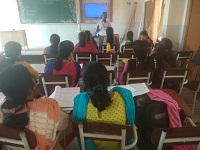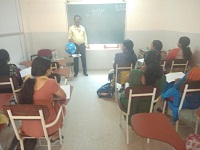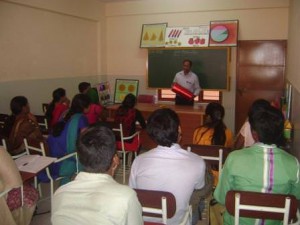 lab are available. English Lab is having “Lingua phone”, Audio equipments with headsets and is helping the students to develop their English pronunciation and teaching method. It supports English methodology students to feel more comfortable in their practice sessions. Kannada lab is also having all the facilities which supports the teacher students to develop their style of teaching and involvement to the language and its culture.
lab are available. English Lab is having “Lingua phone”, Audio equipments with headsets and is helping the students to develop their English pronunciation and teaching method. It supports English methodology students to feel more comfortable in their practice sessions. Kannada lab is also having all the facilities which supports the teacher students to develop their style of teaching and involvement to the language and its culture.Social Science Laboratory: It is a portrait of Indian culture. It consist Art and Architecture of different civilizations of the world.
 It introduces students in the conduct of political, social and economical research using quantitative methodologies. The methods are examined in the context of specific research activities like public opinion surveys, comparisons of political processes in different countries and the evaluation of public policies. It also enhances the knowledge of geography and the horizon of everyday world. Different types of Maps, Charts, and Models are obtained in the Lab.
It introduces students in the conduct of political, social and economical research using quantitative methodologies. The methods are examined in the context of specific research activities like public opinion surveys, comparisons of political processes in different countries and the evaluation of public policies. It also enhances the knowledge of geography and the horizon of everyday world. Different types of Maps, Charts, and Models are obtained in the Lab.Mathematics Laboratory: It is a unique room or place, with relevant and up-to-date equipment known as instructional materials, designated for
 the teaching and learning of mathematics and other scientific or research work, whereby professionally qualified Lecturer readily interact with the students on specified set of instructions. To an approach to teaching and learning of mathematics which provides opportunity to the learners to abstract mathematical ideas through their own experiences, that is to relate symbol to realities. The functions of mathematics laboratory include the followings:
the teaching and learning of mathematics and other scientific or research work, whereby professionally qualified Lecturer readily interact with the students on specified set of instructions. To an approach to teaching and learning of mathematics which provides opportunity to the learners to abstract mathematical ideas through their own experiences, that is to relate symbol to realities. The functions of mathematics laboratory include the followings:
- Arousing interest and motivating learning.
- Cultivating favourable attitudes towards mathematics.
- Enriching and varying instructions.
- Encouraging and developing creative problems solving ability.
- Allowing for individual differences in manner and speed at which students learn.
- Making students to see the origin of mathematical ideas and participating in “mathematics in the making”.
